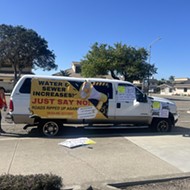'Living New Deal' project explores legacy of FDR's program across the nation, including SLO County
[
{
"name": "Promo Temp Targeted",
"id": "PromoTempTargeted",
"class": "inlineCenter",
"insertPoint": "4",
"component": "15511697",
"requiredCountToDisplay": "0"
},
{
"name": "Ad - Medium Rectangle CC01 - 300x250 - Inline Content",
"class": "inlineCenter",
"insertPoint": "8",
"component": "15582119",
"requiredCountToDisplay": "12"
},{
"name": "Ad - Medium Rectangle LC01 - 300x250 - Inline Content",
"class": "inlineCenter",
"insertPoint": "18",
"component": "15582122",
"requiredCountToDisplay": "22"
},{
"name": "Ad - Medium Rectangle 9 - 300x250 - Inline Content",
"class": "inlineCenter",
"insertPoint": "28",
"component": "15582121",
"requiredCountToDisplay": "32"
}]
If you aren't looking, you just might miss it.
Walking down Chorro Street in San Luis Obispo through an ordinary-looking residential neighborhood between Islay and Leff, you will pass a low wall of old stacked stones spanning a small creek. It is just 14 feet long and 32 inches high.
If you're walking too fast or are busy on your phone, you'll also likely walk right by the small plaque embedded in those stones. Read the plaque, and you'd learn that the little bridge on Chorro Street is a relic of America's recent history, a monument of sorts to one of the country's most sweeping and ambitious infrastructure and job programs, designed to raise the nation and its citizens out of the Great Depression and jump-start the languishing economy.
It was called the New Deal. Spanning the decade between 1933 and 1943, the New Deal was conceived by President Franklin D. Roosevelt and put into action by a series of executive orders and laws passed by Congress, creating a bundle of federal agencies and programs aimed at lifting millions of Americans out of the poverty and joblessness that had gripped the country during the Great Depression. The plan included a massive program of public works and infrastructure projects. Under Roosevelt's New Deal, the now-defunct Works Progress Administration (WPA) built 651,000 miles of highway and 124,000 bridges, and built, rebuilt, or expanded 125,000 public buildings in towns and cities from coast to coast.
According to data from the Living New Deal, a nonprofit research project curated through the Department of Geography at UC Berkeley, SLO County is home to at least eight New Deal infrastructure projects, including the Chorro Street Bridge, which was built between 1939 and 1940 by the WPA. According to The Living New Deal's website, the bridge was part of a larger public works project that included resurfacing eight blocks of Chorro between Pacific and High streets.
"While Chorro Street has been resurfaced many times since 1940, the sturdy rock culvert and its headwall remain evidence of the WPA's earlier work," the website stated.
While the bridge is a small link to the New Deal's legacy in SLO, another, larger project, is still on display in downtown SLO. The art deco-style building on Monterey Street now known as the SLO County Courthouse annex was once the county's courthouse. According to crowdsourcing history website thecelio.com, the WPA built the courthouse in 1940 after its previous incarnation had been demolished.
To the south, the city of Arroyo Grande was home to a successful soil conservation project funded under the auspices of the New Deal. According to a 2010 article by The Tribune, the federal government sent crews from the Civilian Conservation Corps (CCC) and the WPA to work with AG farmers to halt soil erosion on their farmland between 1934 and 1937.
In Morro Bay, a group of World War I veterans employed by the CCC began construction on several projects in what is now Morro Bay State Park. Beginning in May of 1934, the group built the park's entrance road and entrance station, as well as a custodian's lodge, according to historian author Joseph H. Engbeck, who wrote about the project in his book on the CCC, By the People, For the People. The CCC also built an access road at Morro Strand State Beach, according to The Living New Deal's website.
Further north, the WPA was responsible for making several improvements to the Cayucos Morro Bay Cemetery in 1940. The work included the construction of a 335-foot-long stone wall, as well as a wrought iron gate and a sprinkler system. According to what was detailed in the San Luis Obispo County Telegram-Tribune at the time, the project had to be temporarily put on hold due to muddy conditions.
While many New Deal projects like the ones in SLO County may seem like forgotten relics of the past, those at The Living New Deal believe that they continue to be relevant, particularly in light of the country's recent economic struggles.
"We've been brainwashed over the past few decades to believe that the government can't do anything right," Gray Brechin, a geography professor and founder of The Living New Deal, told New Times. "It's important to remind people about a time when the government worked for everyone, not just those people who can afford to buy it."
Brechin likened the thousands of New Deal projects around the nation to artifacts of a "lost civilization," and noted that many of them, like the old SLO County courthouse, are still used by Americans today.
"We need to be more aware of how much we rely on the New Deal today," he said. "Those projects are indispensible to us."
As the project to preserve Roosevelt's New Deal legacy continues, President Donald Trump is laying out his own ambitious plans to rebuild the country's aging infrastructure. In June, Trump rolled out some details on how he plans to make good on campaign promises to foster $1 trillion in infrastructure investment over the next 10 years. The White House's current vision for the program calls for $200 billion in infrastructure funding, including $25 billion for rural infrastructure projects and an eight-year reduction in permit processing time.
Unlike Roosevelt's New Deal, the Trump administration appears to be looking to the private sector to build the projects.
"The president's plan will make America dominant by unleashing private sector capital and expertise to rebuild our cities and states," a statement from the White House read.
A bill for such a program has yet to be introduced or approved by Congress. If that does happen, Brechin is skeptical that it could have the economic impact or historical legacy of Roosevelt's New Deal.
"If there is any public works program, it will simply be a hog trough for [Trump's] associates to feed at," he said. Δ
Staff writer Chris McGuinness can be reached at [email protected].
Latest in News
Readers also liked…
-

SLO police identify alleged driver who hit and killed couple
Dec 22, 2022 -

When the levee breaks: Oceano residents, county officials walk a tightrope of regulations to manage Arroyo Grande Creek, which some say led to the levee's failure in January
May 18, 2023 -

Cal Poly report highlights offshore wind's potential to spur green energy transition
Jun 8, 2023





